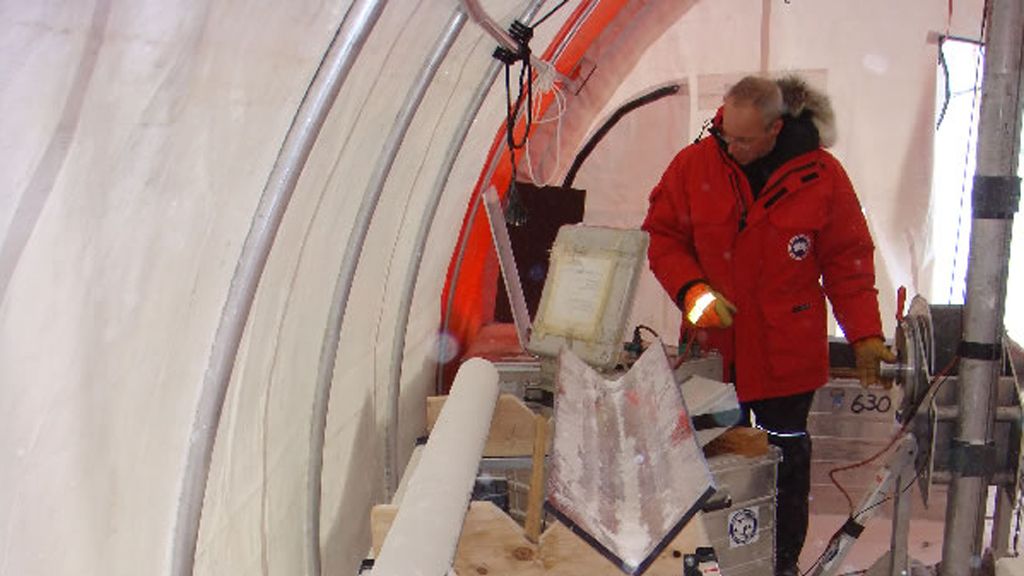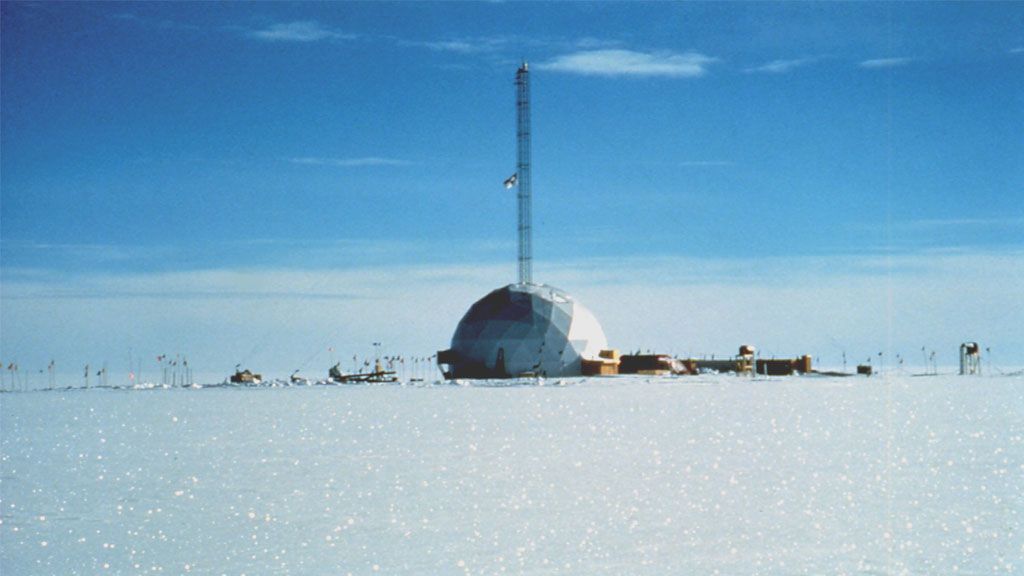Climate cycles and million year old ice
Air bubbles in an ice core
© Eric Wolff / BAS / EPICA
As a leading expert in the study of the chemical composition of snow cover and ice cores and their use in the determination of past climates, pollution and atmospheric chemistry, Professor Eric Wolff from the British Antarctic Survey (BAS) has played a key role in analysing the climate record found in ice cores extracted from Dome C from the centre of the Antarctic Ice Sheet during the European Project for Ice Coring in Antarctica (EPICA) project. Spanning some 800,000 years of cliamte history, the EPICA core is the ice core with some of the oldest ice extracted to date. The air bubbles trapped in the ice form long ago provide a snapshot of what the atmospheric composition of Earth was like hundreds of thousands of years ago, allowing scientists to see how the palenet's climate and levles of carbon dioxide CO2 have been interlinked over the past 800 milennia.
In this interview, Professor Wolff discusses the work of the EPICA project, and how scientists use ice cores to study what the planet's cliamte was like long ago. He also touches upon the quest to find ice from the Antarctic Ice Sheet that is at least one million years old - a quest that could uncover an ever greater wealth of knowledge about Earth's climate history.
In the last few years, your work has mainly focused on the EPICA ice core which was retrieved from Dome C in Antarctica, and which has provided you and your colleagues with 800,000 years of climate history. Has this ice core now yielded all of its secrets?
No, I wouldn't say that the EPICA ice core has yet yielded all of its secrets. Even if the big stories (such as glacial-interglacial variation, the different strengths of warming in each interglacial, and the strong relationship between CO2 and temperature) have come out, some of the records that we've actually measured we still don't completely understand.
What's more, some measurements are only just becoming technically possible, and other have only been done for very short sections of the core. So there is still a lot of work there.
After EPICA, the next step will be to retrieve an ice core that goes back more than one million years. Why is this necessary?
The 800,000 year EPICA ice core shows glacial cycles from warm to cold and back again taking place every 100,000 years, but we know from marine sediments that before that, before one million years ago, the same cycles took place over a much shorter 40,000 years.
Understanding the reasons for this shift from 40,000 to 100,000 cycles is really one of the big questions in our field, because it's the key to understanding why we have the kind of climate that we have now.
But at this point, what do you think are the most probable reasons for this shift?
One of the main ideas or theories, is the average level of carbon dioxide may have decreased, causing a general cooling which allowed ice sheets to get bigger, thus imposing a longer time scale on the whole Earth system.
By retrieving an ice core that goes back to the time of the 40,000 year cycles, we could measure the carbon dioxide level from the air bubbles trapped in the ice and instantly see if it did or didn't change at the time. And if it didn't change we would need to find another hypothesis.
For example, one other idea is that at the time of the 40,000 year cycles, something happening in the North and something happening in the South at other frequencies were cancelling each other out. And there are other hypotheses that we could check by drilling an ice core that goes that far back.
However, I would still hold that the carbon dioxide one is the key one to grasp and answer.
Antarctica's Gamburtsev Province Project (AGAP) has just completed an air-borne survey of the Gamburtsev mountain range that lies beneath the East Antarctic Ice Sheet. Will this data be made available to you, and why is it important for retrieving an ice core that goes back more than one million years?
AGAP has multiple aims, one of which is to map out the Gamburtsev to work out if this was the place from where the East Antarctic Ice Sheet first grew. But another aim was to get the necessary information for us to work out where the oldest ice is at the bottom of the ice sheet. So, yes, the data has been promised to us, and I think it will be made available, especially as this was a collaborative US, British, German, Australian and Chinese programme.
I should point out that the important data for us is the radar data that sounds how deep the ice is and shows the internal layers in the ice which tell you whether it's in the right order or not. But of course, it takes a lot of time to process it.
How much will it cost to retrieve an ice core that goes back more than one million years?
EPICA is estimated to have cost roughly twenty million Euros for each drilling. So it will be at least that...
Has the fundraising process started? Who will put up the money?
We haven't yet applied for funds for the project, but we have advised institutions that we will be doing so. My guess is that the funding will be very multinational.
For EPICA, on the European side, funding was provided by national agencies (whether in direct funding or in kind), as well as by the European Union. For US drilling projects, funding comes from the National Science Foundation (NSF). So my guess is that we will have to have agreements between all of these organizations in order to raise enough funding to carry out this project, which logistically speaking, is very difficult.
How central to the project is China and its new station, Kunlun, which has just been erected at Dome Argus (Dome A)?
China certainly has an important role because of this new station at Dome A, which lies both at the heart of the search area and the highest point of the East Antarctic Ice Sheet, and right over the Gamburtsev mountain range. So it would probably be very difficult to do the project without the logistics the Chinese are developing.
Equally, as of now, the Chinese have limited experience with ice core drilling, so it would probably be risky for them to do it without acquiring this experience through collaboration with other countries. The same is true for the analysis, where no one lab or country would claim to be able to do all that needs to be done. I am not saying that the Chinese would not be able to get this experience, but at this stage I would be surprised if they tried to go ahead completely by themselves.
There have been suggestions that it may in fact be necessary to drill not just one, but two ice cores. Can you explain?
In the science plan that has been written by the International Partnerships in Ice Core Sciences (IPICS), of which all ice coring nations are members, it does stipulate that we should aim for two drillings, because you need a second core to validate the first. And also, when we start drilling in any given place, for a number of reasons which remain difficult to predict, we can never be 100% sure that we will retrieve ice older than what we have already got.
So the aim has always been to have two cores, which of course also has the political advantage that it leaves space for different countries to lead a drilling even if there are other countries taking part. So one possibility is that the Chinese take a lead on one site and involve other people, and maybe for Europe (which obviously had the scientific lead until now) to take a lead on another site, and with other partners, depending on who can contribute funding. But I wouldn't like to rule out any combinations - we will just be very happy if the community as a whole can manage this ambitious project.
And what about the idea of first drilling a shallow core? What would be the purpose of that?
The idea is that before we try and go down all the way to the bedrock, we should drill a core that goes back to the last glacial maximum, 20,000 years ago, in order to check that things like the accumulation rate and temperature are really the way we think they are before we commit the logistics to a full four or five-year project.
According to your explanations during your medal acceptance lecture at the European Geosciences Union (EGU), one important data set that is lacking in our understanding of past Antarctic climate is a record of the extent of sea ice at different periods. Can you tell us why this is so important, and why sea salt deposits found in ice cores might hold the key?
At least for the Polar Regions, the link between temperature and sea ice is absolutely critical. The extent of sea ice affects temperature by several degrees simply because of the sunlight being reflected or absorbed in the ocean (albedo).
Getting sea ice right is key for atmospheric models, for oceanic models, for full climate models, and in order to validate everything else we're doing. And to be honest, it's not something that we are very good at right now, because it is such a difficult thing to get right in all of its different parameters.
Of course, you can get paleo sea ice records from marine sediment by looking at the assembly of different species in the sediment, and finding the ones that live in sea ice. However, in order not to have to survey a huge section of the Southern Ocean, we have a promising idea relating to sea salt in Antarctica, which, as we've discovered in recent years, actually comes from residue lying on the surface of the sea ice, and not from the ocean beneath it.
What this idea suggests, is that the more sea salt we find in any given layer or period, the larger the sea ice extent was at the time.
How does this process work?
The answer lies in our understanding how this sea salt at the surface of the sea ice becomes airborne.
In fact, as the sea ice forms, a layer of salt-rich brine is on the surface and can get sucked into the snow on top. Somehow this salt gets airborne: one idea is that when the snow blows, the wind sublimes away the water vapour and leaves you with particles of sea salt which are just like the ones produced by an open ocean. These get blown into Antarctica by the wind and are eventually deposited after a few days - which is how we find sea salt deposited throughout ice core layers.
Of course if the transport (wind direction) changes, then this will affect the distribution of deposits. But until now, models suggest that this is not such an important factor and that the amount of sea ice will be the main control on the amount of salt in ice cores.
How sure are you of this process?
This is an idea that is around in the literature at the moment, but I should say that it does need further testing. Qualitatively, we think we understand what is going on, but it isn't quantitative yet, because it hasn't been put into a model of any sort.
The reason why interglacial periods start and end is one of the great mysteries you and you colleagues would like to solve. Why is it so important to understand this?
We are living in an interglacial period, so we would like to know when it would come to an end in a natural system, if we were not pumping CO2 into the atmosphere as we are now. I think that is of obvious interest for people living on Earth!
Of course, at the overview level, people do understand why the interglacial start and end. It's based on the amount of sunlight the Earth receives at different times, different latitudes and different seasons, and that's all to do with changes in the Earth's orbit round the sun which have periodicities of many thousand of years. But it's much harder to understand in detail.
Somehow the initial push has to do with the amount of sunlight the Earth receives at different latitudes. But the problem is that that changes by quite a small amount and then gets amplified by internal factors in the Earth system, such as changes in carbon dioxide, changes in sea ice, and so on, which eventually completely swamp the original input change.
The trick is to understand why some of the small changes in input turn into huge changes in climate while others don't.

Eric Wolff
Eric Wolff is the 2009 recipient of the prestigious Louis Agassiz Medal awarded by the European Geosciences Union (EGU). A veteran of six Antarctic and two Greenland seasons, Dr. Wolff has been working for the British Antarctic Survey (BAS) for over twenty years, and has played a central role in the extremely important European Project for Ice Coring in Antarctica (EPICA). A leading expert in the study of the chemical composition of snow cover and ice cores and their use in the determination of past climates, pollution and atmospheric chemistry, Dr. Wolff has published some 130 peer-reviewed journal articles. He is one of the most cited scientists in the climate sciences.
Read More
-
What ice cores from Law Dome can tell us about past and current climates
The Greenland Ice Sheet Project and the International Trans-Antarctic Expedition
EU-PolarNet: Towards closer collaboration on polar research in Europe
Ice shelf channels: important features science is only starting to understand





